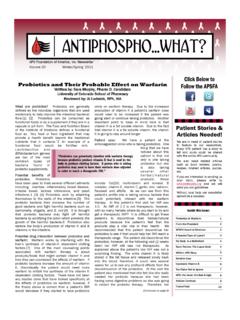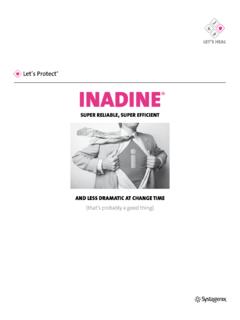Transcription of UNDERSTANDING BLOOD ANALYSIS IN DUI AND TRAFFIC …
1 UNDERSTANDING BLOOD ANALYSIS IN DUI AND TRAFFICHOMICIDE INVESTIGATIONSE ditor: Patrick Mahaney Attorney-at-Law, Montgomery, AlabamaTechnical Editor: Dr. Jack R. Kalin, PhD, DFTCB Toxicology Discipline Chief, Alabama Department of Forensic SciencesTechnical Review: Dr. Jimmie L. Valentine, PhD, Medical Pharmacology and Toxicology Consulting, Ocean Springs, MississippiIntroduction: ANALYSIS of BLOOD evidence in a DUI, TRAFFIC assault, or TRAFFIC homicide case is a critical element of the case for the investigating law enforcement officer as well as the prosecutor.
2 BLOOD samples taken from the defendant are a key piece of evidence in establishing criminal culpability. This document is designed to give the non-scientifically trained law enforcement officer, prosecutor, or attorney sufficient information to understand the basic properties of alcohol and BLOOD , a basic UNDERSTANDING of Alabama law regarding legal issues concerning the admissibility of BLOOD sample evidence, and how BLOOD samples are Alcohol and BLOOD : The BasicsAlcohol: Alcohol1 is one of the oldest substances known to mankind, but its effects are continually being studied, re-studied, and analyzed.
3 Beverage alcohol is commonly referred to as ethanol or ethyl alcohol as well as alcohol. Ethanol is one of a family of alcohols which includes methanol (methyl alcohol or wood alcohol ), 1-Propanol (propyl alcohol), 1-utanol (butyl alcohol), 2-Propanol (isopropyl alcohol or rubbing alcohol ), and ethanediol (ethylene glycol or antifreeze ).1 Origin of the word alcohol : The al in alcohol indicates this is a word of Arabic descent, as is the case with algebra and alkali; al- being the Arabic definite article corresponding to the in English.
4 The origin of cohol is less obvious, however. Its Arabic ancestor was kuhl, a fine powder most often made from antimony and used by women to darken their eyelids; in fact, kuhl has given us the word kohl for such a preparation. Arab chemists came to use al-kuhl to mean any fine powder produced in a number of ways, including the process of heating a substance to a gaseous state and then re-cooling it. The English word alcohol, derived through Medieval Latin from Arabic, is first recorded in 1543 in this sense. The introduction of the word alcohol into the English language came from French, and earlier from Medieval Latin, and is credited to a Latin translation of the works of Rhayzes (865-925), a noted Persian physician, alchemist, and natural invention of the distillation process to produce ethanol as a beverage is credited to Arab and Persian chemists in the eighth Century.
5 However, the technique of distillation would not reach Europe until the twelfth century, and its name from the Arabic al-kuhl would become the basis for the later English word alcohol. Arabic chemists also used al-kuhl to refer to other substances such as essences that were obtained by distillation, a sense first found for English alcohol in 1672. One of these distilled essences, known as alcohol of wine, is the constituent of fermented liquors that causes intoxication. This essence took over the term alcohol for itself, and has come to refer to the liquor that contains this essence, as well as to a class of chemical compounds such as Alcohol CompoundsCommon NameIUPACF ormulaMethyl alcoholMethanolCH3 OHEthyl alcoholEthanolCH3CH2 OHn-Propyl alcohol1-PropanolCH3CH2CH2 OHIsopropyl alcohol2-Propanol(CH3)2 CHOHn-Butyl alcohol1-ButanolCH3 (CH2)2CH2 OHEthyl alcohol (ethanol) is a very small molecule that is completely soluble (miscible) in water.
6 Ethanol is lighter than water. Ethanol has a specific gravity while water has a specific gravity of Additionally, ethanol has a boiling point at 78 degrees Celsius as opposed to water at 100 degrees Celsius. The fact that alcohol is both lighter than water and boils at a lower boiling point is essential in the distillation process. The main source of consumed alcohol is commercially prepared beverages: fermented alcoholic beverages and distilled alcoholic beverages. Beer and wine are typical fermented beverages. In both cases, a natural product (barley in the case of beer and grapes in the case of wine) is fermented by the addition of yeast microorganisms.
7 The alcohol that is produced is the waste byproduct of the metabolism of the yeast s or bacteria s consumption of sugars found in the natural product. Throughout the remainder of this document, the terms ethanol and alcohol may be used Fermentation Process:The UNDERSTANDING of alcohol must begin with the fermentation process. Fermentation of sugars by yeast is the oldest synthetic organic chemical produced by man. During fermentation, sugar is converted to drinking alcohol and carbon dioxide is released as gas bubbles. This chemical change was a great mystery to ancient man because the mixture appeared to be boiling without heat.
8 It was not until the mid-19th Century when the noted French chemist and natural scientist Louis Pasteur discovered that alcoholic fermentation could occur only in the presence of small living ferments or, as they are known today, are eukaryotic microorganisms, classified in the kingdom Fungi, with about 1,500 species currently described; they dominate fungal diversity in the oceans. Most reproduce asexually by budding, although a few do so by binary fission. Yeasts are unicellular, although some species with yeast forms may become multicellular through the formation of a string of connected budding cells known as pseudohyphae, or false hyphae as seen in most molds.
9 Yeast size can vary greatly depending on the species, typically measuring 3-4 m in diameter, although some yeasts can reach over 40 m. The yeast species Saccharomyces cerevisiae has been used in baking and fermenting alcoholic beverages for thousands of years. It is also extremely important as a model organism in modern cell biology research, and is the most thoroughly researched eukaryotic microorganism. Researchers have used it to gather information into the biology of the eukaryotic cell and ultimately human biology. Other species of yeast, such as Candida albicans, are opportunistic pathogens and can cause infection in s study on fermentation:Louis Pasteur (1822-1895) was one of the most extraordinary scientists in history, leaving a legacy of scientific contributions which include an UNDERSTANDING of how microorganisms carry on the biochemical process of fermentation, the establishment of the causal relationship between microorganisms and disease, and the concept of destroying microorganisms to halt the transmission of communicable disease.
10 These achievements led him to be called the founder of modern his early education Pasteur went to Paris, studied at the Sorbonne, then began teaching chemistry while still a student. After being appointed chemistry professor at a new university in Lille, France, Pasteur began work on yeast cells and showed how they produce alcohol and carbon dioxide from sugar during the process of fermentation. Fermentation is a form of cellular respiration carried on by yeast cells; a way of getting energy for cells when there is no oxygen present. Pasteur found that fermentation could take place only when living yeast cells were was then called upon to tackle one of the most persistent problems plaguing the French beverage industry at the time, that of spoilage.






